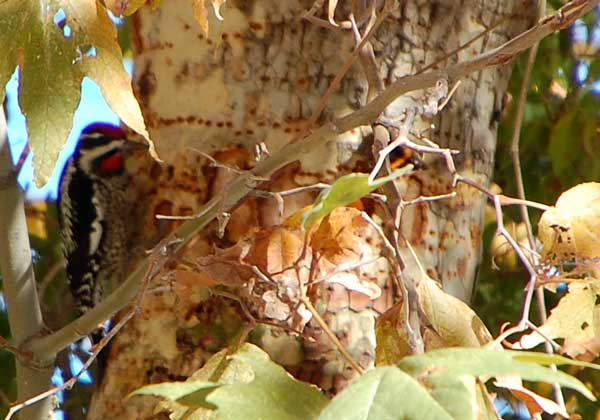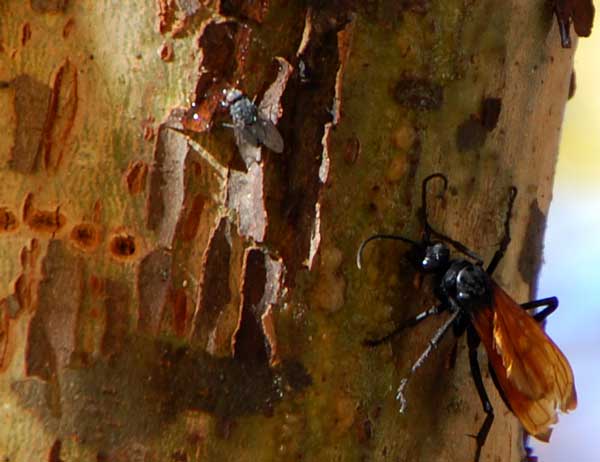Arizona Sycamore &
Red-naped Sapsucker
Platanus wrightii &
Sphyrapicus nuchalis

A red-naped sapsucker creating sap-well holes in trunk of the Arizona Sycamore along Rackensack Wash, Maricopa Co., Arizona, 26 Nov. 2010.
Sapsuckers are woodpeckers that drill a series of holes in live, sap-bearing trees often in horizontal rows encircling the trunks. Soon these holes begin to ooze sap - sap that at once is the tree's defense against injuries but also contains sugars produced by photosynthesis in the leaves. Through the phloem channels in the bark the tree must transport sugars to the root system where root cells use the sugar to draw water and nutrients from the soil.
The sap becomes food for the birds, but also becomes available to an array of other birds, insects and other animals. The injuries if numerous can drain significant energy from the tree and also become an avenue for invading pathogens such as bacteria and fungi.
Sponsored Link:
Arizona Sycamore &
Tarantula Hawk
Platanus wrightii &
Pepsis

The sap-wells created by the red-naped sapsucker bring in a variety of insects. Rackensack Wash, Maricopa Co., Arizona, 26 Nov. 2010.
 Freshly drilled holes take time to fill with sap and the sapsucker must return
hours or days later to reap the rewards. Although the sapsucker will partake in
the sap directly, it is also an insectivore, meaning that the insects that have
come for the sugar may themselves be taken prey by the woodpecker. In essence
the woodpecker baits for it's catch. At left is a tarantula hawk, a wasp that
hunts and paralyzes large spiders. Sugar is a welcome treat for the energy
content that fuels the wasp's hunting efforts. Tarantula hawks have powerful
stings and so the sapsucker will likely leave it alone in favor of less
hazardous meals. Also in the photograph is a smaller fly, probably a
sarcophagid.
Freshly drilled holes take time to fill with sap and the sapsucker must return
hours or days later to reap the rewards. Although the sapsucker will partake in
the sap directly, it is also an insectivore, meaning that the insects that have
come for the sugar may themselves be taken prey by the woodpecker. In essence
the woodpecker baits for it's catch. At left is a tarantula hawk, a wasp that
hunts and paralyzes large spiders. Sugar is a welcome treat for the energy
content that fuels the wasp's hunting efforts. Tarantula hawks have powerful
stings and so the sapsucker will likely leave it alone in favor of less
hazardous meals. Also in the photograph is a smaller fly, probably a
sarcophagid.